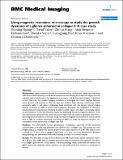| dc.contributor.author | Huang, Shuning | |
| dc.contributor.author | Vader, David | |
| dc.contributor.author | Wang, Zhihui | |
| dc.contributor.author | Stemmer-Rachamimov, Anat | |
| dc.contributor.author | Weitz, David A. | |
| dc.contributor.author | Dai, Guangping | |
| dc.contributor.author | Rosen, Bruce R. | |
| dc.contributor.author | Deisboeck, Thomas S. | |
| dc.date.accessioned | 2010-10-12T15:29:56Z | |
| dc.date.available | 2010-10-12T15:29:56Z | |
| dc.date.issued | 2008-01 | |
| dc.date.submitted | 2007-06 | |
| dc.identifier.issn | 1471-2342 | |
| dc.identifier.uri | http://hdl.handle.net/1721.1/59062 | |
| dc.description.abstract | Background: Highly malignant gliomas are characterized by rapid growth, extensive local tissue infiltration and the resulting overall dismal clinical outcome. Gaining any additional insights into the complex interaction between this aggressive brain tumor and its microenvironment is therefore critical. Currently, the standard imaging modalities to investigate the crucial interface between tumor growth and invasion in vitro are light and confocal laser scanning microscopy. While immensely useful in cell culture, integrating these modalities with this cancer's clinical imaging method of choice, i.e. MRI, is a non-trivial endeavour. However, this integration is necessary, should advanced computational modeling be able to utilize these in vitro data to eventually predict growth behaviour in vivo. We therefore argue that employing the same imaging modality for both the experimental setting and the clinical situation it represents should have significant value from a data integration perspective. In this case study, we have investigated the feasibility of using a specific form of MRI, i.e. magnetic resonance microscopy or MRM, to study the expansion dynamics of a multicellular tumor spheroid in a collagen type I gel. Methods: An U87mEGFR human giloblastoma multicellular spheroid (MTS) containing approximately 4·103 cells was generated and pipetted into a collagen I gel. The sample was then imaged using a T2-weighted 3D spoiled gradient echo pulse sequence on a 14T MRI scanner over a period of 12 hours with a temporal resolution of 3 hours at room temperature. Standard histopathology was performed on the MRM sample, as well as on control samples. Results: We were able to acquire three-dimensional MR images with a spatial resolution of 24 × 24 × 24 μm3. Our MRM data successfully documented the volumetric growth dynamics of an MTS in a collagen I gel over the 12-hour period. The histopathology results confirmed cell viability in the MRM sample, yet displayed distinct patterns of cell proliferation and invasion as compared to control. Conclusion: In this study, we demonstrate that a specific form of MRI, i.e. magnetic resonance microscopy or MRM, can be used to study the dynamic growth of a multicellular tumor spheroid (MTS) with a single cell scale spatial resolution that approaches the level of light microscopy. We argue that MRM can be employed as a complementary non-invasive tool to characterize microscopic MTS expansion, and thus, together with integrative computational modeling, may allow bridging of the experimental and clinical scales more readily. | en_US |
| dc.description.sponsorship | National Institutes of Health (U.S) (CA 085139 ) | en_US |
| dc.description.sponsorship | National Institutes of Health (U.S) ( CA 113004) | en_US |
| dc.description.sponsorship | National Center for Research Resources (U.S.) (P41RR14075) | en_US |
| dc.description.sponsorship | Harvard-MIT (HST) Athinoula A. Martinos Center for Biomedical Imaging and the Department of Radiology at Massachusetts General Hospital | en_US |
| dc.publisher | BioMed Central Ltd | en_US |
| dc.relation.isversionof | http://dx.doi.org/10.1186/1471-2342-8-3 | en_US |
| dc.rights | Creative Commons Attribution | en_US |
| dc.rights.uri | http://creativecommons.org/licenses/by/2.0 | en_US |
| dc.source | BioMed Central Ltd | en_US |
| dc.title | Using magnetic resonance microscopy to study the growth dynamics of a glioma spheroid in collagen I: a case study | en_US |
| dc.type | Article | en_US |
| dc.identifier.citation | BMC Medical Imaging. 2008 Jan 29;8(1):3 | en_US |
| dc.contributor.department | Harvard University--MIT Division of Health Sciences and Technology | en_US |
| dc.contributor.mitauthor | Huang, Shuning | |
| dc.contributor.mitauthor | Rosen, Bruce R. | |
| dc.contributor.mitauthor | Deisboeck, Thomas S. | |
| dc.relation.journal | BMC Medical Imaging | en_US |
| dc.eprint.version | Final published version | en_US |
| dc.identifier.pmid | 18230155 | |
| dc.type.uri | http://purl.org/eprint/type/JournalArticle | en_US |
| eprint.status | http://purl.org/eprint/status/PeerReviewed | en_US |
| dc.date.updated | 2010-09-03T16:13:54Z | |
| dc.language.rfc3066 | en | |
| dc.rights.holder | Huang et al.; licensee BioMed Central Ltd. | |
| dspace.orderedauthors | Huang, Shuning; Vader, David; Wang, Zhihui; Stemmer-Rachamimov, Anat; Weitz, David A; Dai, Guangping; Rosen, Bruce R; Deisboeck, Thomas S | en |
| mit.license | PUBLISHER_CC | en_US |
| mit.metadata.status | Complete | |
